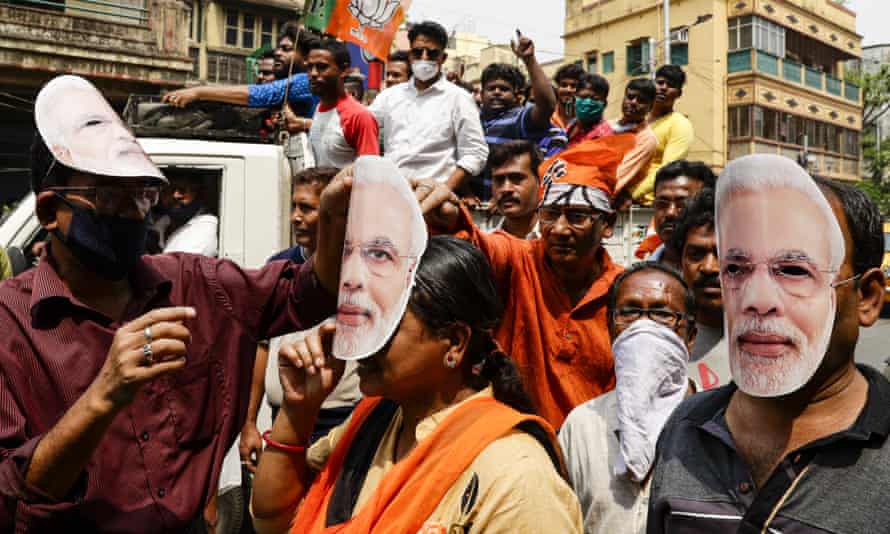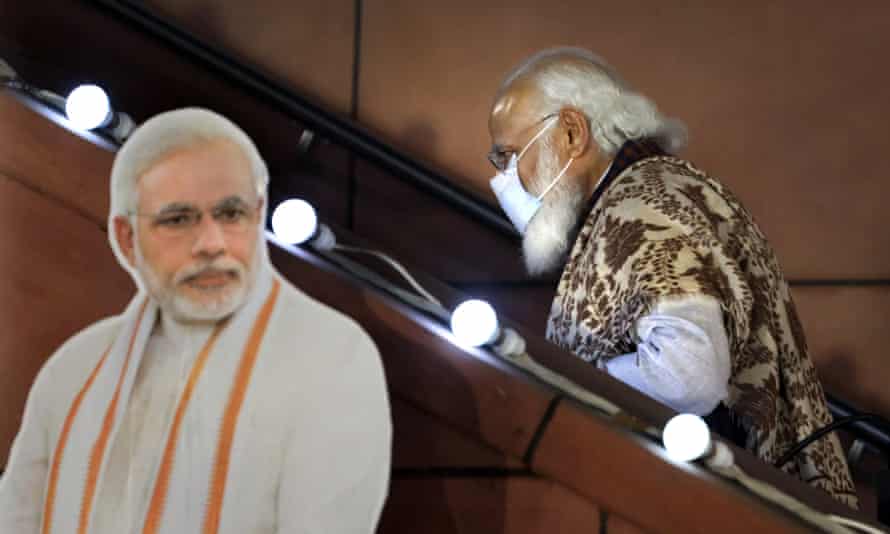The missing persons complaint was filed at Parliament Street police station in Delhi as a matter of some urgency: it concerned the “disappearance of Prime Minister Narendra Modi” and 10 of his cabinet ministers during the pandemic.
Nagesh Kariyappa, the general secretary of the Indian national students’ union who filed the report to police on Friday, said he wanted the absence of political leadership when India had been brought to its knees by Covid-19 to be a matter of official record. “Where are the so-called leaders who had promised to make India a global leader but have instead made people suffer like this?” said Kariyappa.
As a devastating second wave of coronavirus has engulfed India in recent weeks, taking India’s tally of cases above 20m and the official death toll to more than a quarter of a million – a figure most experts consider to be a vast undercount – the Bharatiya Janata party (BJP) government led by Modi has faced an unprecedented and visceral wave of public anger.
Modi came to power in 2014 on promises of growth and prosperity, and won another sweeping majority in 2019. He has deflected civil unrest, economic decline and some backlash against his Hindu nationalist agenda to remain India’s most popular prime minister in years, his approval rating hitting 80% earlier this year.
But with so many people losing loved ones due to a lack of hospital beds, oxygen, ventilators and vital medicines across the country, and with a chronically underfunded, under-resourced healthcare system pushed to the brink of collapse, tough questions are being asked for the first time about Modi’s competence and leadership.
“Modi’s image will depend on how the mass suffering is interpreted, and whether he can successfully deploy his skills at narrative shifting, but I think he will have to pay a price,” said Ashutosh Varshney, director of the Centre for Contemporary South Asia at Brown University in the US.
“This is too immense a period of suffering and it will be too hard to convince people that this was just down to ‘divine will’ or individual failures to wear a mask etc.”
In the city of Panchkula, in the BJP-ruled state of Haryana, Chetan Tikoo stood cremating his 75-year-old father who had died from Covid. Gesturing to the many burning pyres of other Covid victims at the crematorium, Tikoo said the consequences of the government’s handling of the pandemic were “here for you to see”.
“Everybody is angry,” said Tikoo. “It is a collective failure. This is how I look at it. Whether it is the state government or the central government, everybody has failed. The planning was bad and the government should have definitely not held state elections.”

Outside Mankian village in Haryana, a village that previously voted for the BJP, anti-Modi sentiment is now so high that a sign was recently erected prohibiting any BJP politicians from entering the village.
Karamchand Singh, an autorickshaw driver from Ramgarh village who has been struggling to make ends meet during the pandemic, said he had voted for Modi in 2019 but had now lost all faith in him. “ Look at the number of people who have died,” he said.
The prime minister stands accused of turning a blind eye to warning signs of the second wave, ignoring the advice of scientists and fuelling a culture of complacency at the top levels of government by allowing state elections, political rallies and religious festivals to go ahead and “victory” to be declared over the pandemic. The vaccination programme, meanwhile, has been crippled by severe shortages blamed on an earlier lack of orders from the government, and state governments have been pitted against each other for supplies.
“There is barely anyone in India that hasn’t been touched by this pandemic, and the level of anger and outrage that’s being directed towards Modi, particularly from the urban middle classes where he traditionally has a strong base of support, is the highest it’s been since he was elected prime minister,” said Milan Vaishnav, director of the south Asia programme at the Carnegie Endowment for International Peace.
“It’s palpable, you see it on social media, you see when talking to friends and family, you even see it in the fact that Modi has become the butt of jokes on WhatsApp.”
This week anti-government posters appeared in neighbourhoods across Delhi emblazoned with the question “Modi, why did you send our children’s vaccines abroad?”. More than 20 people have been arrested for displaying the posters.
Modi’s home state of Gujarat has been accused of some of the most egregious misreporting of the toll of the pandemic. Death certificate records gathered by the state newspaper suggest up to 17 times more deaths than official records show.
As the crisis has unfolded, Modi, who has built his reputation as a strongman politician who leads from the front, has become conspicuous by his absence from the public eye. It has led to accusations of abandonment and abdication of responsibility.

“Alongside vaccines, oxygen and medicines, the PM has also vanished,” tweeted the opposition leader Rahul Gandhi this week, while India’s Outlook magazine ran a cover this week with the words “Missing. Name: Government of India. Age: 7 years.”
The government’s decision to push ahead during the pandemic with the controversial £2bn renovation of the parliament building and surrounding Central Vista area in Delhi, a project that has been described as Modi’s “vanity project” and includes the construction of a palatial new residence for the prime minister, has also drawn criticism.
The BJP has begun a concerted campaign to try to seize back the initiative, pushing a strong narrative of “positivity” as the way forward. The government has instructed diplomats to counter the coverage in international media that Modi’s government is failing.
While the government was quick to centralise the credit for defeating the pandemic in February, it is now decentralising blame, shifting responsibility for the spread of the second wave on to state governments, in particular Delhi and Maharashtra.
The BJP vice-president, Baijayant Panda, said that “by no stretch of imagination can it be stated that the prime minister or his cabinet had taken the virus lightly”. He maintained the government had been “fully aware” that a second wave might come about and accused states such as Maharashtra, Chhattisgarh, Punjab and Kerala – all ruled by opposition parties – of ignoring “multiple warnings” and turning down central government offers of help.
“Healthcare is a state subject under the constitution of India. However, whenever there has been oxygen shortage or a shortage of hospital beds anywhere in the country, the centre and its agencies have tried to rise to the occasion,” he said. “Had those warnings been heeded by the government of Maharashtra and the caseload been brought under control then there would have been no chance for the emergence of the new variant that is roiling the state and the rest of the country now.”

While Modi’s well-cultivated image of competence and strength may have taken a battering, Vaishnav, like many political observers, remains sceptical that he will pay any long-term political price. The main opposition Congress party is riddled with disunity, has performed dismally at recent state elections, and its de facto leader remains Gandhi, who lost crushingly to Modi in the 2019 general election.
“At the national level, in terms of party organisation, in terms of messaging and in terms of leadership, we don’t have a single opposition, and that is a huge gift to Modi,” said Vaishnav.
Nonetheless many have pointed to the BJP’s recent defeat in the West Bengal state elections as an indicator that is at state level where dissatisfaction with Modi could play out damagingly for his party, and even pave the way for the possibility of an opposition alliance between powerful regional parties to challenge the BJP on a national level.
The state elections in Uttar Pradesh in March next year, where the BJP-controlled government is led by one of Modi’s closest and most hardline allies, will be the first test of the political toll of the pandemic on Modi and the BJP.
“There will be some fall for Modi out of this,” said Varshney. “The big question that remains to be seen is, how big will the fall be?”
Additional reporting by Tripti Nath
This content first appear on the guardian
